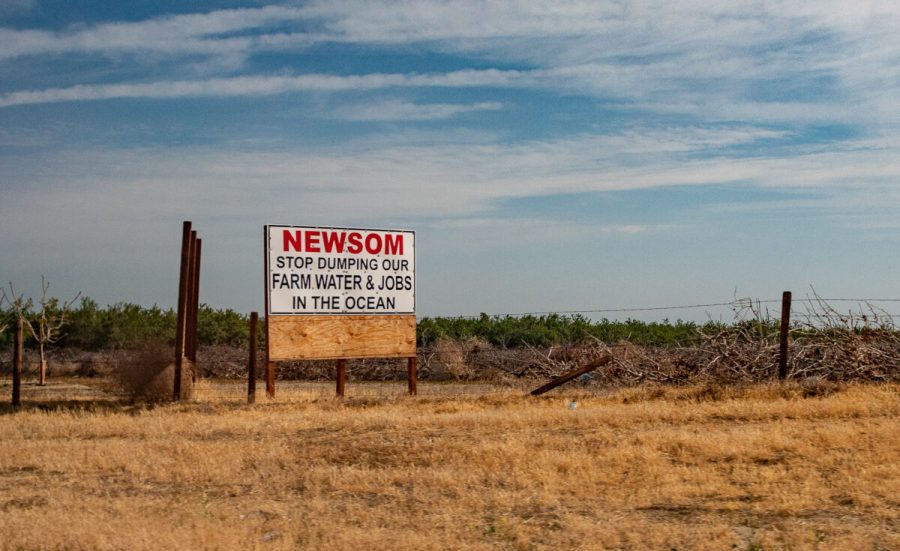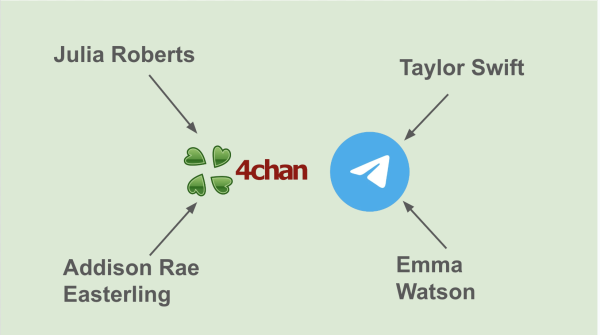Column: California’s drought is affecting our agriculture
Photo credit: John Fredricks
Farmers put up signs off California’s 5 Freeway outside of Bakersfield on April 18, 2022. With extreme drought water restrictions farmers have been forced to leave thousands of acres idle, directly impacting the agricultural economy and their livelihoods. Photo used with permission from the Epoch Times.
November 6, 2022
As I was heading northbound on the I-5 to visit friends in San Francisco, rows of almond trees and grapevines stretched as far as I could see. However, what caught my attention most wasn’t the beautiful scenery but instead the number of political signs positioned at the end of every few rows. The signs read, in bright red letters, “Newsom, Stop Dumping Our Farm Water & Jobs in the Ocean.”
Whether we think it affects us or not, we are in a drought, and a bad one at that. The start of October marked the beginning of a new “water year,” but this new year wasn’t one worth celebrating. This year marked the driest consecutive 3-year period for California on record since 1896.
The word “drought” is far from a new term for me. I’ve grown up turning the water off as I brush my teeth, taking quick showers and cringing at the sight of a hose running loose on the ground. I remember when my neighbor’s plush green lawn turned into a native drought-resistant one — it seemed like we were always in a perpetual “drought,” and not being conscious of my water usage was a pipe dream.
California is annually entitled to 4.4 million acre-feet of the Colorado River’s water, the majority of which is used for agriculture. However, two of the Colorado River’s largest reservoirs, Lake Mead and Lake Powel, are close to running dry. And, according to Cal Matters, water agencies are offering to reduce California’s water usage by 400,000 acre-feet every year untill 2026. This amounts to 9% of the river’s water California is entitled to under its “senior rights.”
In order to achieve this, Gov. Gavin Newsom passed emergency water restrictions for California, which were implemented in January of this year and called for residents to stop watering lawns and using fountains.
But, this isn’t enough. Not enough of us are following these restrictions.
Additionally, the water that we do have, we’re wasting. “Dumping water in the ocean” has been a popular buzzword among politicians and critics alike. This comes from misconceptions regarding California’s Sacramento-San Joaquin Delta. The delta is an important estuary (where salt and fresh water meet) for California’s wildlife providing a habitat for a diverse array of ecosystems. However, when the estuary’s freshwater content reduces, it becomes inhabitable for certain vital species. This prompts California officials to release Sierra snowpack runoff into the estuary.
In a drought as severe as this one, “dumping” vital fresh water into the “ocean” when the agricultural industry barely has enough to fully operate, doesn’t look good. However, in complex situations like these, it’s easy to get caught up in surface judgments, when the real question is, whose hindered more? Who has more options? If more Californians followed water restrictions would we be so tight for agricultural water?
It seems like a common theme for most Californians is to leave their problems, to someone else and seldom do we understand that our routines can and will make a difference. We know we’re in a severe drought, but when the worst of the effects rarely reach us, it’s hard to take action. Yet, those which our inaction is affecting the most are facing irreversible impacts as we continue to take and take and take.
According to an article written in the Los Angles Times, California’s agriculture industry is the largest in the country with over $50 billion in annual revenue, employing more than 400,000 people. With farms growing nuts, fruits, and cotton, California’s central valley is filled with endless rows of production. We even produce more peaches than Georgia, a fact my friend from Atlanta was not too happy about as we made our way further along the 5.
In 2021, the drought took 8,745 agricultural jobs and shouldered $1.2 billion in direct costs as water cutbacks forced growers to fallow farmland and pump more groundwater from wells according to the Los Angeles Times. Furthermore, a report conducted for the California Department of Food and Agriculture showed that in 2021, 395,000 acres of cropland were left dry and unplanted due to a lack of water — that’s bigger than Los Angeles! It’s difficult to comprehend these challenges, especially when we are privileged enough to not see the full impacts of this drought.
The loss of agricultural revenue from the drought has significant implications for the central valley economy and those living in the area. The central valley is one of the poorest areas in the state, and, due to the loss of jobs, people are forced to drive farther distances for work or relocate entirely. With the multitude of negative implications on California’s agriculture and the seemingly never-ending drought, it’s no surprise California’s farmers are angry.
Water is a gift from this earth that sustains us. We share our water with everyone, and the way we use it has direct and irreversible effects on California’s agriculture industry. We believe the drought is distant from us or our concerns, but it’s not. It’s real, and it’s not going away anytime soon. I don’t say these things to cause panic but to call us to action. We must do what we can to help for the future of our planet and the future of our livelihoods.





![Freshman Milan Earl and sophomore Lucy Kaplan sit with their grandparents at Archer’s annual Grandparents and Special Friends Day Friday, March 15. The event took place over three 75-minute sessions. “[I hope my grandparents] gain an understanding about what I do, Kaplan said, because I know they ask a lot of questions and can sort of see what I do in school and what the experience is like to be here.](https://archeroracle.org/wp-content/uploads/2024/03/grandparents-day-option-2-1200x800.jpg)





























































